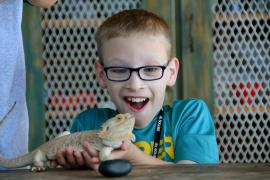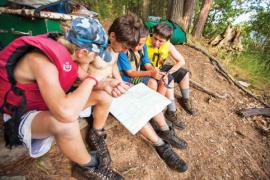What progress have you seen in the movement to connect children and nature since you wrote Last Child in the Woods in 2005?
Last Child didn’t create the children and nature movement. That was already percolating, and America’s camps have always been part of that. But the book proved to be a useful tool, and I’m grateful for that. For the most part, it’s self-organizing. It transcends political, religious, racial, economic, and geographic divides. It touches people’s hearts. And, as I write in The Nature Principle, I believe it can serve as a model for a broader “new nature movement.”
We’re seeing signs of progress. During the past five years, the Children & Nature Network (www.childrenandnature.org), which grew out of Last Child, has tracked the emergence of some ninety regional and state campaigns. We’ve seen legislative progress at the national and state levels. Nonprofits and businesses have joined up. Government agencies and nonprofit conservation organizations have increased their emphasis on this issue. Education appears to be making a slow turn back toward nature experience. Family nature clubs — some with hundreds of families as members — are catching on. I hope that nature-focused camps have received more public support, too. This movement is increasingly international.
In 2012, what do you consider the biggest challenges facing the children and nature movement?
Among the specific challenges are the need for more research, parental fear and overprotectiveness, urban design (which often discourages nature experience), and the litigious society. In a recent blog, I suggested that it’s time for a national, or international, conference on children, nature, and the law. (View that blog at http://richardlouv.com/blog/enough-isenough-time-for-a-national-conferenceon-children-and-adults-natu/.)
Two other challenges stand out. The growing constrictions of government funding and foundation support are real and unlikely to go away soon. So we need a different approach — one focused less on specific programs and more on planting seeds for self-replicating cultural change. In The Nature Principle, I describe a “third ring” of action for social change, one that camps could encourage. In that ring, groups such as family nature clubs can grow organically, independent of traditional funding constraints. If those seeds can be planted, they’ll begin to grow and multiply on their own, changing the culture and, at the same time, creating a new political and social constituency for camps and other programs that connect all of us to nature.
Also, progress for children won’t continue unless efforts to connect kids to nature are part of a broader movement that reaches people of every age, who begin to realize the role of nature in their own mental and physical health, productivity, and creativity.
What role can the environmentbased education movement play in the national debate about educational reform and twenty-first century skills?
Environment-based educators already play a vital role, of course, and have for many decades. They can be the most effective ambassadors for the need for environmental literacy. But they can also expand their role as champions for naturalizing learning environments — encouraging natural play spaces at schools and in neighborhoods, promoting the use of biophilic design for schools (thus making them much more conducive to learning and creativity), working for the return of recess and field trips, and creating naturefocused schools, especially preschools. In addition to environmental educators, other educators — the English teachers, art teachers, and others who insist on taking their students outdoors to learn — should be honored and encouraged.
Also, after-school or out-of-school educators and the role of the wider community in education should be encouraged. In November, 2010, two Oregon State University researchers, writing in American Scientist, made the case that “an evergrowing body of evidence demonstrates that most science is learned outside of school.” In “The 95 Percent Solution,” John H. Falk and Lynn D. Dierking write, “The ‘school-first’ paradigm is so pervasive that few scientists, educators, or policy makers question it. This despite two important facts: Average Americans spend less than 5 percent of their life in classrooms, and an ever-growing body of evidence demonstrates that most science is learned outside of school.” This means that after-school and summer education programs — including camps — can give students a different and possibly more effective learning experience than the traditional classroom.
What can camps do to become more intentional about helping children form a personal connection with the natural world?
As Barry Garst, ACA’s director of program development and research application, has pointed out, “camps have developed generations of people who are in touch with nature” and “few places other than camps provide children with the opportunity and freedom to connect with nature and also caring mentors . . . .”
In the age of virtual experience, camps can do even more to emphasize the health and cognitive benefits of the reality-based nature connection. I continue to argue that the most important educational gift we can give children and young people is not more information, though information is important, but more experience, especially nature experience. The role that camps — naturefocused and some other kinds of camps as well — can play in this is substantial, and many of us hope it can be expanded. Camps can emphasize the benefits of the learning environment of nature, its impact on developing brain architecture.
In the new book, I write about what I call the “hybrid mind,” which amplifies the sensory and creative benefits of both virtual and natural experience. Camps can offer environments that provide balance. They can certainly help kids learn to use all of their senses at the same time. Scientists who study the human senses no longer talk about only five senses, but as many as thirty. Many of these senses can be stimulated through immersion in natural environments. Not only do young people (and adults) who learn to use more of these senses feel more alive, they’re also better learners. In addition, it’s important to let parents and young people know that kids need some degree of risk experience in order to avoid more dangerous risks later. (Please see the sidebar at the bottom of this page, which links to blogs and articles that can help traditional camps better market the benefits of nature exposure at their camps.)
What sort of innovative partnerships are needed to connect kids from diverse cultural and socio-economic backgrounds to the natural world?
The starting place, in my opinion, is to partner with the communities themselves, not only to discuss the barriers to nature, but to tap into what I’ve called “natural cultural capacity” — to learn more about the strengths and capacities of how different cultures do connect with the natural world. Here’s one example. National and state park officials describe, with appreciation, how Hispanic families tend to use parks for family picnics and reunions — social activities now seemingly rare among non-Hispanic whites. Why not encourage that? Some park officials are doing just that. African Americans also bring their own heritage to the outdoors. Some camps are already tapping natural cultural capacity.
In addition, camps could work more closely with pediatricians and other health professionals. We see emerging partnerships between state and urban parks and health professionals who are beginning to write “park prescriptions” to help their patients become healthier. It’s an exciting development, and it’s spreading here and in Europe. The transcript for my keynote speech to the 2010 National Conference of the American Academy of Pediatrics, which addresses this idea, can be found at http://richardlouv.com/blog/grow-outside-keynote-address-to-the-american-academyof-pediatrics-national/. Nature-focused camps, and other camps, could forge similar partnerships, and some may already be doing this.
Another conduit into diverse cultural and socio-economic groups is the library. Neighborhood libraries exist in many types of communities. In the upcoming paperback edition of The Nature Principle, I suggest the potential for a national library campaign to connect people to the nature in their own communities. I’m thinking of the Long Island library that created a 5,000 square-foot outdoor reading and play space. In addition to adding nature directly to the library facility, libraries can also become information centers for bioregion. Nature-focused camps in a bioregion could take a leadership role, along with conservation and environmental education groups, in helping libraries take on that role. Libraries can offer area maps, pamphlets on local nature, brochures for hiking and for family nature clubs, registries for community gardens, information about summer and day camps, and even outdoor gear for checkout. (In New York, some already offer fishing rods for checkout.) Libraries can convene groups of architects, urban designers, educators, physicians, and other professionals to plan the re-naturing of the community — and they can be meeting and recruiting places for camps and camp programs.
Many of us would also like to see even more philanthropic support from the wider community to support and grow all camps, especially those that are nature-based — perhaps a general fund for contributions from people who may not have a connection to a specific camp, but want to give general support to that cause.
In The Nature Principle, you paint a hopeful picture of a future where people live balanced, nature-rich existences within strong, vibrant communities. This actually describes the environment created in many camps. How can camps actively promote, teach, and model your concept of “thriveability” to create a convergence between camps, communities, schools, and the children and nature movement?
Camps can include (and go beyond!) the traditional environmental literacy message to help young people and their families learn about how time spent in nature can help them be healthier, happier, and smarter. They can encourage young and older people involved in camps to take nature back to their own families and communities. One way would be for camps to send such tools as the Children & Nature Network’s free Family Nature Club Tool Kit home to parents, encouraging them to create these year-round experiences on their own, by partnering with other families. (ACA is one of the sponsors of that tool kit, available online at www.scribd.com/collections/3265609/Grassroots-Guides-Tool-Kits.) C&NN provides a number of other tools and networks for fami ly and community change, including the Natural Leaders Network (for young people), and the Natural Teachers Network, in support of educators who continue to take their students outdoors to learn. And of course there are many other groups (such as Nat ional Environmental Educat ion Foundation, National Wildlife Federation, and Sierra Club) that provide great tools.
One of my favorite ideas comes from Doug Tallamy, of the University of Delaware, who wants to create a “Homegrown National Park” by encouraging people to plant native species in their yards. He’d like to enlist homeowners and neighborhoods across the country into what would essentially be a vast network of biodiversity corridors — ones that help make our cities into biodiversity engines, and would also improve our health and well-being. Why not include camps in the Homegown National Parks, both as participants and also as advocates?
In fact, ACA and individual camps could become leading organizations in a new nature movement — a broad-based effort that includes and goes beyond traditional definitions of environmentalism and sustainability. Through a new nature movement, people can imagine and eventually create a society in which our lives are as immersed in nature every day — where we live, work, learn, play, (and camp) — as they are in technology. The more high-tech our lives become, the more nature we need.
Note: Some of the ideas discussed above are drawn from both Last Child in the Woods and The Nature Principle, including a new section added to the paperback edition of the latter book, called “Toward a New Nature Movement.” The paperback should be out and available by the time of the 2012 ACA National Conference in February.
Reference
Falk, J., and Dierking, L. (2010). The 95 percent solution. American Scientist, 98.
Richard Louv is founding chairman of The Children & Nature Network (www.childrenandnature.org). For more information about his books, go to www.richardlouv.com.
Originally published in the 2012 January/February Camping Magazine.


